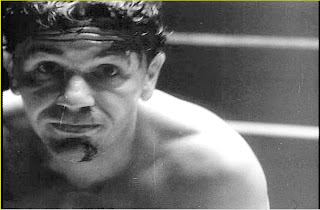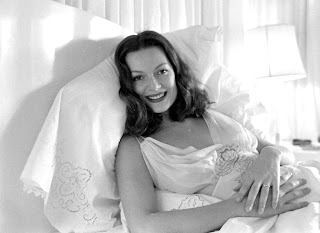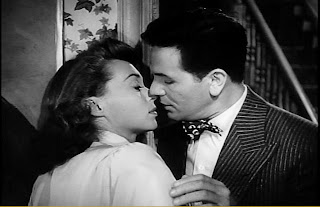Jessica Tandy & Marlon Brando-A Streetcar Named Desire (Radio Version): Tennessee Williams' "A Streetcar Named Desire" wins the Drama Critics' Award and Elia Kazan and Irene Selznick accept.

The original Broadway cast (Marlon Brando, Kim Hunter, Jessica Tandy) performs. When the curtains closed on the play's first night on Broadway, on December 3, 1947, the crowd shared a moment of stunned silence, then burst into applause that lasted a full 30 minutes.

With Jessica Tandy under Kazan’s direction, Blanche became a symbol of a dying tradition, and we welcome Stanley’s hostilities.
With Clurman as director, Uta Hagen made Blanche the victim of Stanley’s destructive society, Hagen’s Blanche under Clurman’s direction left audiences feeling they had watched a delicate woman driven insane by a brutish environment epitomized by Stanley Kowalski. Tandy’s Blanche under Kazan’s direction left audiences feeling that a madwoman had entered an alien world and after shaking that world had been successfully exorcised.
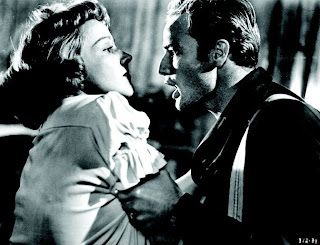
"Williams said from that apartment he could hear that rattletrap streetcar named Desire running along Royal," Kenneth Holditch says, "and one named Cemeteries running along Canal. And it seemed to him the ideal metaphor for the human condition."

Jessica Tandy photographed on 24th April, 1949, as Blanche DuBois in "A Streetcar Named Desire".
That metaphor finds its expression within the play in the character of Blanche DuBois -- originally played by Jessica Tandy -- a fragile southern belle who visits her sister Stella, played by Kim Hunter
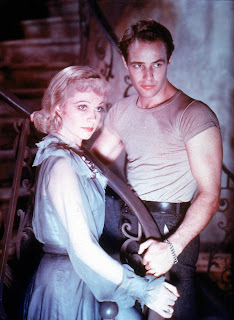
The starting point for most studies on symbolism in Streetcar is the play’s epigraph, taken from Hart Crane’s last great poem, “The Broken Tower”: "I entered the broken world to trace the visionary company of love". Antithetical to these studies is Deborah Burks’s "Treatment Is Everything: The Creation and Casting of Blanche and Stanley" which focuses mainly on the development not of Blanche but of Stanley.

Burks says that during the play’s preparation for the Broadway stage, Williams did not know how Stanley was to function in opposition to Blanche. Burks reprints Williams’s 29 August 1947 letter to Audrey Wood where he praises the discovery of Marlon Brando. In Brando’s reading for the part, Williams found what had been lacking all along in his vision of Stanley —humanism. Williams articulates this newly discovered balance thus, “I don’t want to focus guilt or blame on any one character but to have it a tragedy of misunderstanding and insensitivity to others”.

This first school of critics who argue that 'Streetcar' is a social drama of naturalistic determinism and Blanche and Stanley cultural or human nature types may seem often at either ends of a philosophical continuum. Indeed, scholars cannot seem to agree if Williams is interpreting Strindberg, Chekhov, Nietzsche, or Darwin. But all have the common denominator that 'Streetcar' is essentially a social drama with its characters representing some philosophical or political credo.

The second school, who views 'Streetcar' as a sociodramatic study of victimology, eschews this philosophical base, stressing instead that Blanche and Stanley are unique individuals and we are witnessing a private battle between them. Unfortunately, this school, too, cannot agree upon what it is that we are in fact witnessing. The neutral party finds Williams unbiased, supplying us simply with a study of Lawrentian blood knowledge or the Eros/Thanatos life/death drive. Therefore, several studies, including a book-length one by Norman Fedder, have focused on the Lawrentian elements in Williams’s plays.

It is not surprising, then, to find several references to the Blanche-Stanley conflict as Williams’s study of the Eros/Thanatos instinct made famous in Lawrence’s fiction. And while Jack von Dornum sees Stanley as “D.H. Lawrence’s natural man”, Robert Brustein perceives Stanley as the Lawrence hero “whose sexuality, though violent, is unmental, unspiritual, and, therefore, in some way free from taint.” Brustein also sees the conflict between Stanley and Blanche as an allegory of the struggle between “effeminate culture and masculine libido.”

But it is Christopher Bigsby in “Tennessee Williams: Streetcar to Glory” and Arthur Ganz in “The Desperate Morality of the Plays of Tennessee Williams” who offers the most cogent analyses along these lines: Bigsby, in discussing Williams’s Promethean Man in characters like John Buchanan and Stanley Kowalski, both of whom survive at the expense of the delicate, romantic people; and Ganz, in tracing the “neo-Lawrentian” elements in Williams’s plays prior to 1962. Bigsby argues that of all of Williams’s earlier plays which preach “the Lawrentian sermon on the dominance of the physical over the spiritual”, it is not until 'Streetcar' that Williams “managed fully to digest his Lawrentian lessons and incorporate them into his own perception of an American caught in transition from genteel sterility to brutal indifference”.

Philip Kolin, a professor of English and author of several books on Streetcar, puts the magnitude of the play in perspective. "People have said that Williams absolutely invented the idea of desire for the 20th century," he says. "It was a play that dealt with for the very first time on the American stage, female sexuality and male sexuality."

From his private director’s notebook, published for the first time in 1976, Kazan informs us as to where his sympathies lay. Although he identifies with Blanche’s plight, his support is with Stanley.
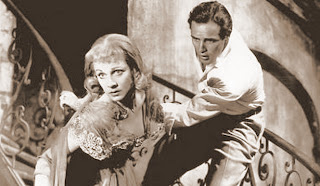
In his Stanislavskian reading of Streetcar, looking for the “spine” of each character, he concludes that Stanley’s “spine” is to keep things his way, that he must fight off the destructive intrusions of Blanche who “would wreck his home,” Blanche is dangerous. She is destructive. She would soon have him and Stella fighting. He’s got things the way he wants them around there and he does not want them upset by a phony, corrupt, sick, destructive woman.

Kazan’s direction heavily favored making Stanley the victim of Blanche’s onslaughts against his name, his heritage, his masculinity, and ultimately his family. It was not until Harold Clurman took over as director of the road version of the play that a shift to Blanche as victim took place, a shift which would inaugurate the timeless debate over Streetcar’s meaning.

Vivien Leigh (Blanche DuBois) lunches with Marlon Brando (Stanley Kowalski) and Kim Hunter (Stella Kowalski).

The opposition between Blanche and Stanley is not between cultural types, but between human types. Thus, whereas one side argues that Williams is creating a Blakean chiaroscuro as embodied in Nietzsche’s Apollonian/Dionysian personality types, the other side finds in 'Streetcar' the simple display of Darwinian natural selection which Tennessee Williams himself emphasizes. In his 'Birth of Tragedy', Nietzsche describes an archetypal struggle between restraint (Apollonian) and passion (Dionysian). In his analysis of 'Streetcar', subtitled “Nietzsche Descending”, Joseph Riddel asserts that Williams borrowed from Nietzsche “in great chunks, often undigested”. The Apollonian figure is characterized by restraint and order, the Dionysian by passion and metaphysics.

Riddel points out that Blanche is Apollonian and Stanley Dionysian, but the reason 'Streetcar' fails is because Williams misinterpreted Nietzsche. By suggesting that Dionysian behavior often dominates the Apollonian, Nietzsche did not mean that passion defeats restraint, as Williams thought, but that order moves inevitably toward chaos. Joseph Riddel is not the only critic to make the Nietzschean connection. Judith J. Thompson describes 'Streetcar'’s mythos as a “dramatic agon” between Stanley (Dionysus) and Blanche (Pentheus), based on Euripides’ 'The Bacchae'.

Britton J. Harwood in his “Tragedy as Habit: A Streetcar Named Desire” also finds the Apollonian/Dionysian dialectic in the Blanche-Stanley conflict, but Harwood sees the struggle better described in Rudolf Otto’s terminology: Self versus Other. Harwood sees the crux of 'Streetcar' as a code of loyalty both upheld and betrayed. -"CRITICISM ON A STREETCAR NAMED DESIRE - A Bibliographic Survey" (1947-2003) by JOHN S. BAK

Marlon Brando as Johnny Strabler in "The Wild One" (1953) directed by Laslo Benedek

"An actor is at most a poet and at least an entertainer". -Marlon Brando

"If you want something from an audience, you give blood to their fantasies. It's the ultimate hustle". -Marlon Brando

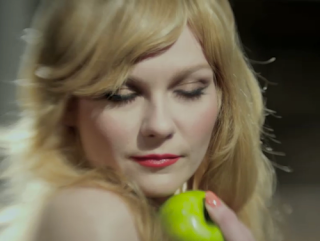 Kristen Dunst in "Touch Of Evil" videoclip from The New York Times, December 2012
Kristen Dunst in "Touch Of Evil" videoclip from The New York Times, December 2012 Marlene Dietrich as Tanya in "Touch of Evil" (1958) directed by Orson Welles
Marlene Dietrich as Tanya in "Touch of Evil" (1958) directed by Orson Welles There, Marlene Dietrich's madame — like the good woman of earlier noir films — represents for Quinlan an idealized and unattainable past. Tanya has all of the surface characteristics of a mysterious spider woman: long, dark hair, earrings, a foreign accent, heavy makeup, and an ever-present cigarette trailing smoke that obscures the jaded expression on her face. Yet, as each of Quinlan's friends abandons him, Tanya alone remains true to Quinlan and at least for a moment - helps him escape both from Vargas and from his own self-created demons. The film implies that she loved him, and indeed she is the only person who appreciates the tragedy of his fall and seems moved by his death. In contrast to Dietrich's redemptive prostitute,
There, Marlene Dietrich's madame — like the good woman of earlier noir films — represents for Quinlan an idealized and unattainable past. Tanya has all of the surface characteristics of a mysterious spider woman: long, dark hair, earrings, a foreign accent, heavy makeup, and an ever-present cigarette trailing smoke that obscures the jaded expression on her face. Yet, as each of Quinlan's friends abandons him, Tanya alone remains true to Quinlan and at least for a moment - helps him escape both from Vargas and from his own self-created demons. The film implies that she loved him, and indeed she is the only person who appreciates the tragedy of his fall and seems moved by his death. In contrast to Dietrich's redemptive prostitute, Suzy Vargas (Janet Leigh) embraces her traditional role within the status quo family.
Suzy Vargas (Janet Leigh) embraces her traditional role within the status quo family. But in this film, as in Pitfall, D.O.A., The Big Heat, and Kiss Me Deadly, the traditional woman has become a source of danger, vulnerability, and restraint rather than redemption. Source: www.lib.berkeley.edu
But in this film, as in Pitfall, D.O.A., The Big Heat, and Kiss Me Deadly, the traditional woman has become a source of danger, vulnerability, and restraint rather than redemption. Source: www.lib.berkeley.edu Quinlan: Come on, read my future for me.
Quinlan: Come on, read my future for me.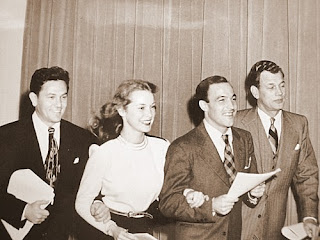 John Garfield, Janet Leigh, Gene Kelly and Joseph Cotten in a photo issued as publicity for the 'Hollywood Players' radio show (1947)
John Garfield, Janet Leigh, Gene Kelly and Joseph Cotten in a photo issued as publicity for the 'Hollywood Players' radio show (1947) John Garfield and Shelley Winters in "He Ran All The Way" (1951) directed by John Berry
John Garfield and Shelley Winters in "He Ran All The Way" (1951) directed by John Berry John Garfield entertains a USO show at the Hollywood Canteen
John Garfield entertains a USO show at the Hollywood Canteen "All he (John Garfield) cared about was acting and dames." -Actor Dane Clark
"All he (John Garfield) cared about was acting and dames." -Actor Dane Clark John Garfield and Phyllis Thaxter in "The Breaking Point" (1950) directed by Michael Curtiz
John Garfield and Phyllis Thaxter in "The Breaking Point" (1950) directed by Michael Curtiz





